Wondering what traditional Dutch food is like? In this article, we’ll show you a bunch of delicious food from the Netherlands!
From mouthwatering sweets to hearty meals, food in the Netherlands is a serious business and if you haven’t had these Dutch dishes yet, you’re missing out.
Whether you’re visiting Amsterdam and wanna know what to eat there or you simply want to incorporate some Dutch food traditions into your menu planning, this article is everything you need.
You’ll be pleased to know that this list of Dutch food was put together by Dutch locals!
Yes, my husband was born and raised among beautiful windmills, tulips, and lots of cheese, and I have been living in the Netherlands long enough to call myself Dutch—that’s what makes this article so special!
So, grab your bite and read further to know more about what Dutch people eat!
Check out our complete Dutch Pantry at Amazon. We selected special products and brands we use (or eat!) and recommend. Click here to our Dutch Pantry!
Traditional Dutch Food
We organized this article in a way that makes it easy to navigate. First, you’ll find Dutch meals, the real food Dutch people eat for dinner. Then, famous Dutch snacks, sweets, regional, and seasonal. Smakelijk!
Dutch Meals
1. Stamppot

In the Netherlands, cold weather is an invitation to stamppot. This traditional Dutch dish is made of mashed potatoes with kale and sausage.
There are of course many variations of it, where we use sauerkraut, endive, and spinach instead of kale. Still, stamppot with kale is by far the most traditional one.
We may also add bacon in cubes and serve with gravy. Yum, stamppot is the perfect Dutch dinner on a cold winter day.
2. Hutspot

Hutspot is a variety of stamppot, and it is typical Dutch food for the winter. Winters here can be pretty cold, but this dish will warm you up!
On top of that, hutspot is simple to make, and it’ll easily satisfy your hunger.
It consists of potatoes, carrots, and onions which are boiled together in a big pan, and mashed afterward. It can be flavored with salt and pepper, of course. Pretty simple, but tasty!
It is traditionally served with smoked bacon, meatballs, or a traditional Dutch sausage.
3. Kapsalon – Dutch Fast Food

Kapsalon is a mouthwatering combination of delicious ingredients and a not-so-healthy part of the Dutch diet.
It consists of a layer of fries, followed by a layer of kebab or shawarma, melted cheese, some vegetables, and is usually served with garlic sauce.
Kapsalon is actually a fast food, a hearty one that is especially welcome after a night of drinking out.
It all started in 2003 when a barber from Rotterdam had a local snack bar prepare this dish because it contains his favorite ingredients. Because he regularly ordered it, the Dutch shop gave it a name: kapsalon, which means barbershop in Dutch.
The kapsalon didn’t remain unnoticed, and in no time it became a popular Dutch dish.
4. Pea soup – Erwtensoep

Erwtensoep is a very thick pea soup, which the Dutch call ‘snert.’ It is a Dutch food people usually have in the winter because it warms you up.
The main ingredients are peas and potatoes and may also contain cabbage, leek, carrot, and onion.
There are a few variations of ‘snert’, though. It can be eaten with rookworst (smoked sausage) or bread and bacon.
All these ingredients make it a savory dish that gives you enough energy to fight the cold. Lots of Dutch families eat pannenkoeken, Dutch pancakes, after the soup.
5. Boerenkool met rookworst

Boerenkool met rookworst also is a traditional food from the Netherlands. It is kale mashed together with potatoes and diced bacon.
The traditional way of eating this delicious meal is by making a small hole in the middle and pouring some gravy in there.
On the side, people usually eat rookworst. This is a sausage in which ground meat is mixed with spices and salt, and stuffed into a casing.
Boerenkool can be found throughout the country, and some regions have their own name for it. In the southern province of Limburg, people call it ‘boeremoos’.
6. Dutch Pancakes – Pannenkoeken

This Dutch pancake is larger and thinner than the American pancake.
Also, instead of eating it for breakfast, Dutch people usually eat Pannenkoeken for dinner, and it can be savory, with bacon or cheese, or sweet, with powdered sugar or syrup.
You can easily find this Dutch food in Holland and other regions too. There are a number of pancake houses in the country.
Check out our complete Dutch Pantry at Amazon. We selected special products and brands we use (or eat!) and recommended. Click here for our Dutch Pantry!
Dutch Snacks
7. Dutch French Fries

Dutch fries (patat or frietjes) are one of the most common Dutch snacks you will find in the Netherlands.
But it isn’t just fries as you would imagine. We eat it with mayonnaise, curry ketchup (a spicy ketchup), and onions.
Another common sauce in the country is peanut sauce. Still, curry ketchup tastes like heaven in this dish.
8. Worstenbroodjes

Worstenbroodjes originated in the province of Noord-Brabant, in the south of the Netherlands.
The outside is made of a soft type of dough, and on the inside, you’ll find a beef sausage. This savory Dutch snack tastes best when it’s still warm.
Dip it in ketchup and enjoy this delicious Dutch food!
Back in the day, people were trying several ways to keep the meat from spoiling. One of these ways was to roll it in the dough…and the worstenbroodje was born!
9. Kroket

A Kroket is one of the many foods Dutch people love to eat with their fries. It consists of a crunchy layer of dough and bread crumbs and is usually filled with beef ragout.
There are numerous delicious variations of the kroket, where the beef is replaced by another ingredient.
Think of goulash, potato, chicken, shrimp, and, of course, cheese. It’s Dutch after all 😉
Regardless of the stuffing of your kroket, dipping it in mustard is a blessing for your taste buds!
Local tip: Be careful when eating one, the ragout on the inside can be extremely hot!
Read next: 10 Best Street Markets in Amsterdam
10. Frikandel
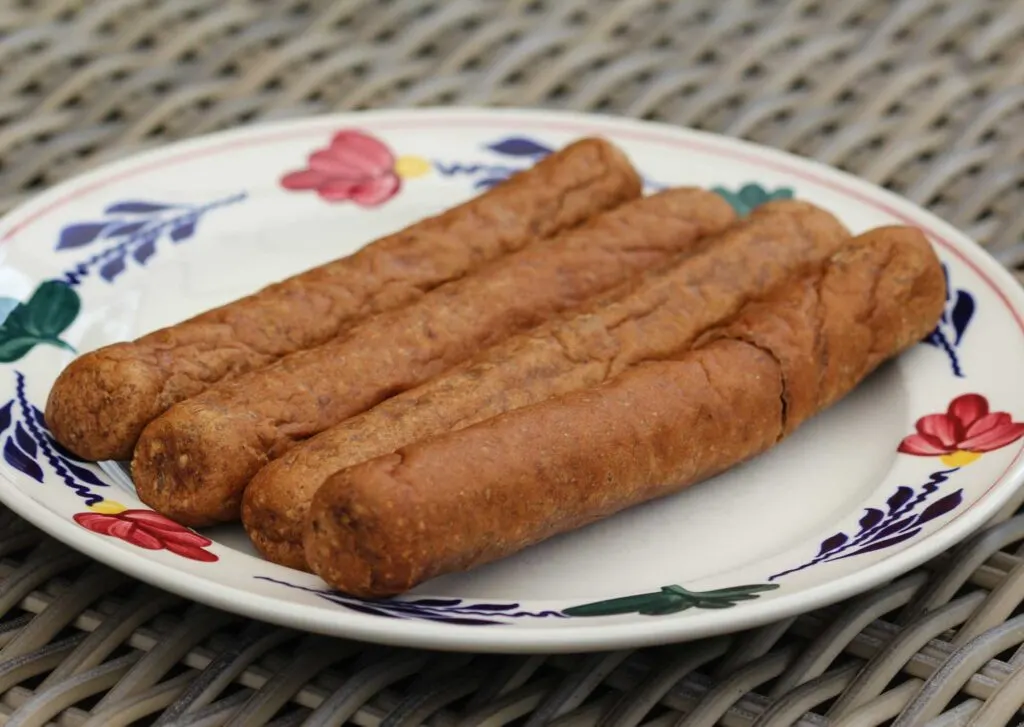
The frikandel is a deliciously fried sausage made out of chicken and pork. It is often served together with fries, and it tastes excellent with mayonnaise. Another way to eat it is to add a few ingredients to it.
The Dutch like to cut it open and put onion, mayonnaise, and curry (note that curry in The Netherlands is a kind of herb ketchup), or with regular ketchup. This is called a ‘Frikandel Speciaal.’
Fun fact: The Frikandel used to be round like a meatball, but because of a change of the Dutch food laws, they had to change this snack. Instead of changing the recipe, they only changed the shape!
11. Bitterballen

Bitterballen are very similar to the kroket; only the shape is different. Where the kroket is narrow and long, bitterballen are small and round.
This makes them the #1 party snack, and they are often served in a big bowl with some mustard on the side. Besides mustard, they also go exceptionally well with some beers.
Local tip: Bitterballen can be very hot, so don’t put a whole ball in your mouth. Bite it first to open the snack so the hot air can get out.
12. Kibbeling

Kibbeling is a delicious Dutch snack that is usually made of whitefish (or cod, pollock, tilapia, and many others), cut into small pieces. These pieces are dipped in a mixture of flour, egg, beer, and spices, and then fried.
Kibbeling is served with a flavorsome sauce, either remoulade or ravigote sauce. We like both and most people just call it Kibbelingsaus.
While you won’t easily find this snack in the south of the Netherlands, it is everywhere in coastal provinces like Zeeland and, of course, North-Holland.
13. Bamiblok
Another fried snack. The Dutch sure like frying stuff! Bamiblok and bamischijf are the same; only the shape is different.
A ‘blok’ is rectangular, and a ‘schijf’ is round. As the name might suggest, the inside contains ‘bami,’ an Asian dish.
This is most likely a result of the Indonesian influence in Dutch cuisine. The outside, once again, is made of dough and breadcrumbs. In our opinion, a bamiblok with ketchup is very tasty when served with some fries.
14. Nasischijf
Yep. Another Dutch snack. The idea of the nasischijf is the same as the bamiblok above – let’s take an Asian dish, wrap it in dough and bread crumbs, and fry it.
This also originates from the Indonesian influences in the Netherlands. Below the crunchy outside layer, there is a savory stuffing made of nasi which can be slightly spicy.
Just like the bamiblok, ketchup and the nasischijf make a happy marriage.
15. Raw Herring

The Dutch have been dealing with water for centuries now. So it makes sense that one of the most famous Dutch foods is fish.
The traditional Dutch fish, herring, is served raw with chopped onions and gherkins. This is very “lekker,” the Dutch word for tasty.
Dutch people usually eat herring also on vlaggetjesdag (Flag Day) as a tradition that dates back to the 14th century when fishermen went out to the sea to capture the annual catch.
We know fresh fish doesn’t look that appealing, but herring is delicious. Trust us on that!
You can find many fish stalls with this food from Holland throughout coastal cities.
Dutch Desserts & Dutch Sweets
16. Dutch Apple Pie

Dutch Apple Pie is a very traditional Dutch sweet, and it dates back to the Middle Ages when a simple recipe for apple pie was found in a 1514 cookbook.
Nowadays, there are two kinds of apple pie in the Netherlands: one with a lattice crust and one with butter crumbs on top (appelkruimeltaart). The difference between these two is the texture–one is crunchier than the other.
Bakers usually add several spices to the pie, such as cinnamon and powdered sugar. With such smells and flavors, apple pie is a Dutch food that always makes us think of Christmas and those cheerful festivities with family.
17. Dutch Waffles – Stroopwafel

This Dutch treat was first made in Gouda in the late 18th century or early 19th century. And today these stuffed waffles are very popular among tourists (and locals) because it’s utterly delicious!
Stroopwafels are two thin layers of baked dough, almost like cookies, filled with caramel syrup… You can imagine why people are crazy about it, right?
It’s delicious and pairs perfectly with a freshly brewed cup of coffee.
18. Poffertjes

Poffertjes are tiny fluffy pancakes served with powdered sugar and butter—mouthwatering for sure!
You can eat these traditional Dutch treats all year long, but they’re more popular during winter and in Christmas Markets.
Also, you can find these treats in Holland food stalls in touristy cities. We highly recommend it!
19. Hagelslag – Chocolate Sprinkles

Hagelslag is the traditional chocolate sprinkles people eat around the world. The ones you find on donuts, for example.
Still, the thing here is that we, Dutch people, eat it on bread for breakfast. Say what?
There are all kinds of varieties: pure chocolate, white chocolate, milk chocolate, fruity sprinkles, and a mix of them all in one pack.
20. Speculaas cookie

This Dutch cookie is a crunchy spiced biscuit that has figures on it from Sinterklaas stories.
Some say this is the reason it’s called speculaas which means mirror in Latin.
This cookie brings out the flavors of Christmas: warm spices in sweet cookies. Its main ingredients are white pepper, cinnamon, ginger, cloves, cardamom, and nutmeg.
Local tip: Dip it in coffee and thank us later.
Read next: Best Things to Do in Amsterdam
21. Speculoos Cookie Spread
This creamy spread with caramelized granular looks a lot like peanut butter.
However, this spread is a variation of the cookie we mentioned above, speculaas. And just as the cookies, it is delicious when served with coffee.
22. Tompouce

Tompouce is a rectangular pastry filled with whipped cream and covered with a thin layer of pink icing.
However, pink turns into orange around King’s Day as this is the Dutch Royal Family’s color.
It’s a Dutch food tradition to serve it on birthdays or national celebrations.
However, it’s humanly impossible to eat it without making a mess. You’ve been warned!
Fun fact: This Dutch pastry’s name was inspired by the French translation of Tom Thumb, a character of the English folklore.
Traditional Food From the Netherlands
23. Drop (Licorice)
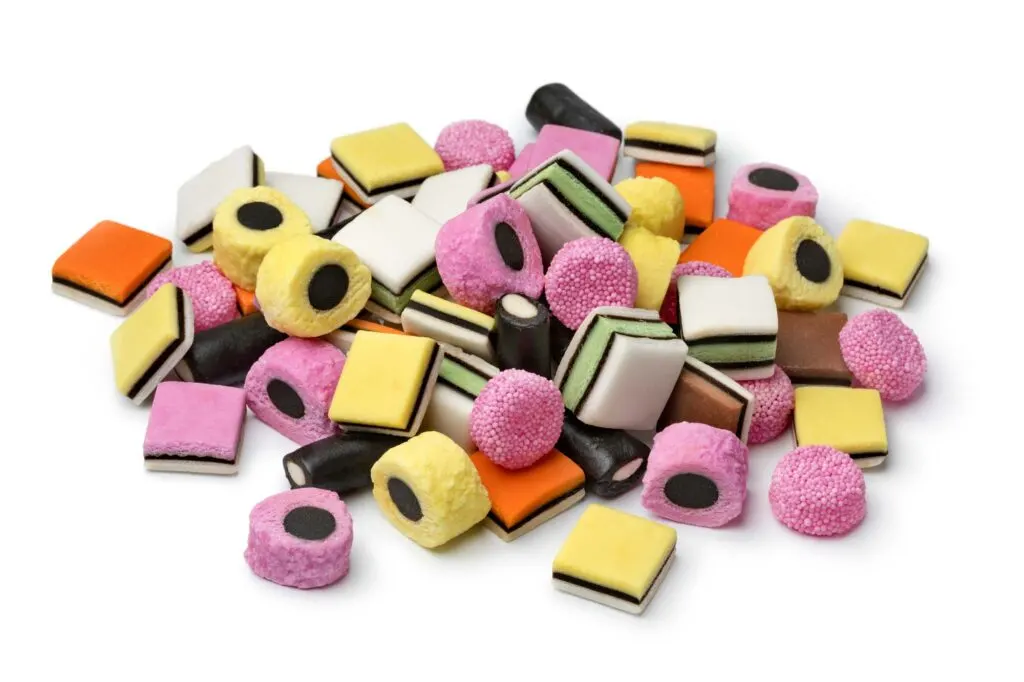
You either hate it, or you love it. As a Dutchman, my husband loves it, but he has met quite some people from abroad who strongly disagree with him, including me.
Once he bought a pack of this Dutch candy for my family, a Brazilian family, but he ended up eating it all by himself because they did not like it. 🙂
The drop is usually flavored with the extract of the roots of the licorice plant, and in the Netherlands, there are lots of variations of it – hard, soft, sweet, salty, extra salty, to name a few.
24. Dutch Cheese

The Netherlands is famous for being one of the biggest cheese exporters in the world. So, don’t miss the opportunity to eat delicious Dutch cheese if you can!
There are different sorts of Dutch Cheese such as Gouda, Maasdam, Edam, and Leyden.
If you’re in the country, there are many cheese markets in the Netherlands where you can not only experience the Dutch traditions but also buy some dairy products to bring back home.
25. Ossenworst

Back in the 17th century, the Dutch would import lots of oxen from Denmark and Germany.
Butchers used ox meat to make ‘ossenworst,’ which means Oxen Sausage. The sausage was brought to taste with several spices, such as pepper and nutmeg.
Nowadays, this delicious sausage is no longer made of ox meat, but of beef and it is traditionally served with ‘Amsterdamse uitjes’ (small yellow onions) or pickles.
Regional Dutch Cuisine
26. Limburgse Vlaai

Vlaai is a Dutch sweet pie consisting of a pastry and filling. This tantalizing treat is called Limburgse vlaai because it’s only found in the province of Limburg.
However, it originally comes from Germany, and since its proximity, you can find vlaai in both Limburg and some regions in Belgium.
There are all sorts of flavors: rijstevlaai (rice pudding), kruimelvlaai (crumbed butter and custard pudding), kersenvlaai (cherry), and many others.
Dutch people usually eat vlaai on birthdays or at celebrations. But remember, only in Limburg.
Read next: 3 Days in Amsterdam
27. Bossche Bol
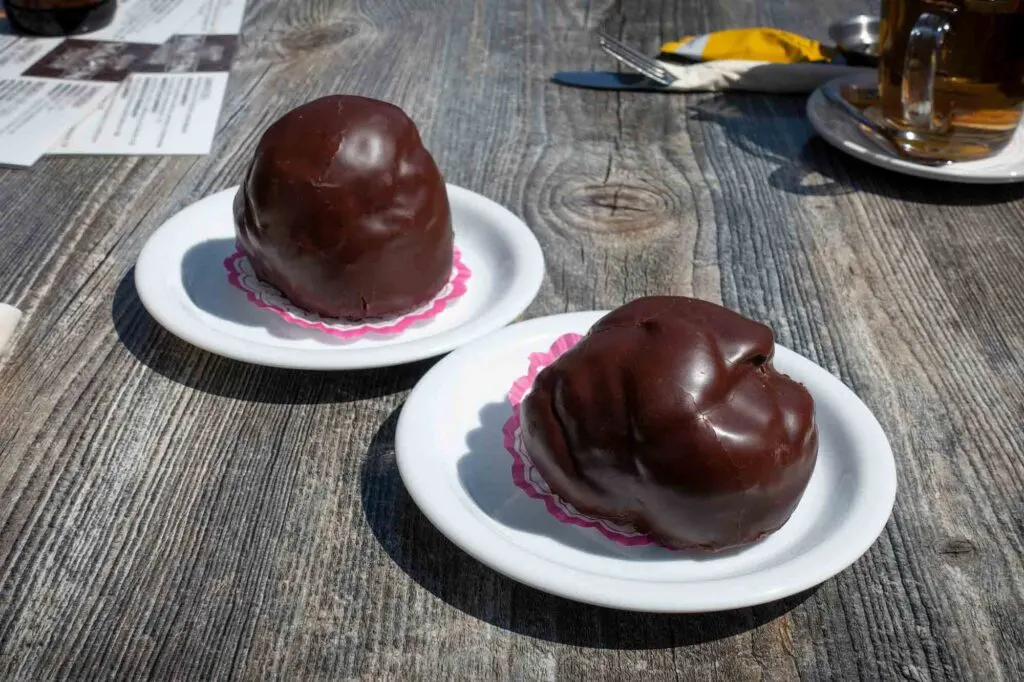
Imagine a pastry ball filled with whipped cream and covered with a hard layer of dark chocolate.
The mouthwatering Bossche Bol has this name because it comes from Den Bosch, a Dutch city in the province of North Brabant.
The pastry that gave the Bossche Bol life was first made in the 20th century and was filled with custard. Years later, another baker made a few changes to the recipe, and today we have this drolling-worth pastry.
Local tip: Eat it upside-down to avoid squirting out the filling as the bottom doesn’t have the icy chocolate layer.
Seasonal Dutch Treats
28. Oliebollen
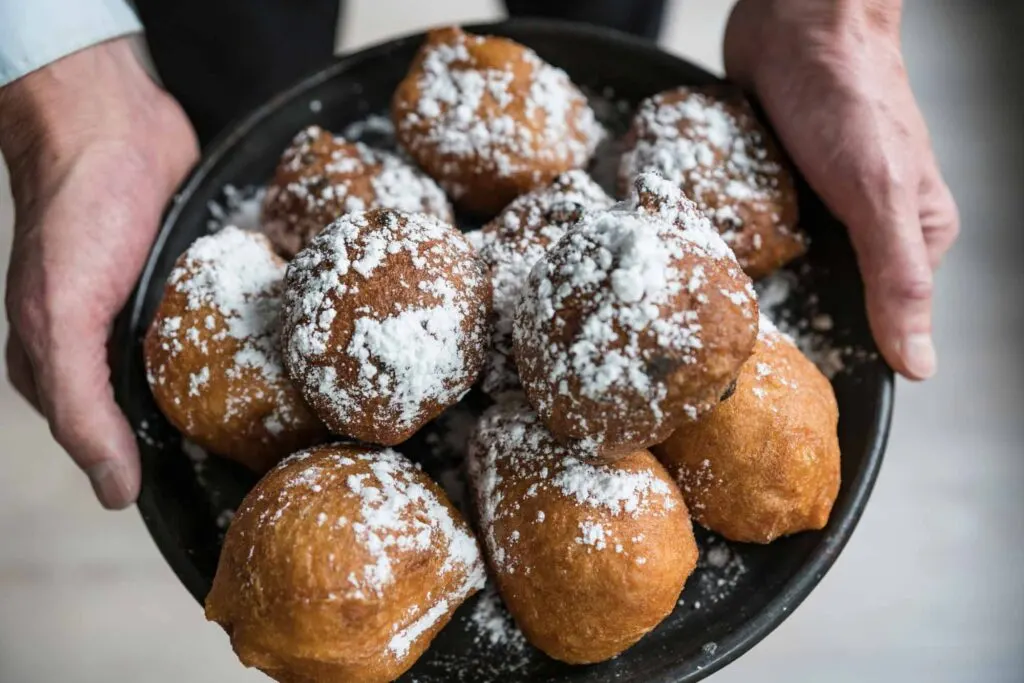
This delicious Dutch Christmas food is basically a fried dough ball sprinkled with powdered sugar.
There can be variations of it, such as the addition of chopped apples and raisins. However, the original one is only dough and powdered sugar.
As a Dutch food tradition, people usually eat oliebollen on New Year’s Eve, and you can find stands selling it in many cities during the winter.
29. Beschuit met Muisjes
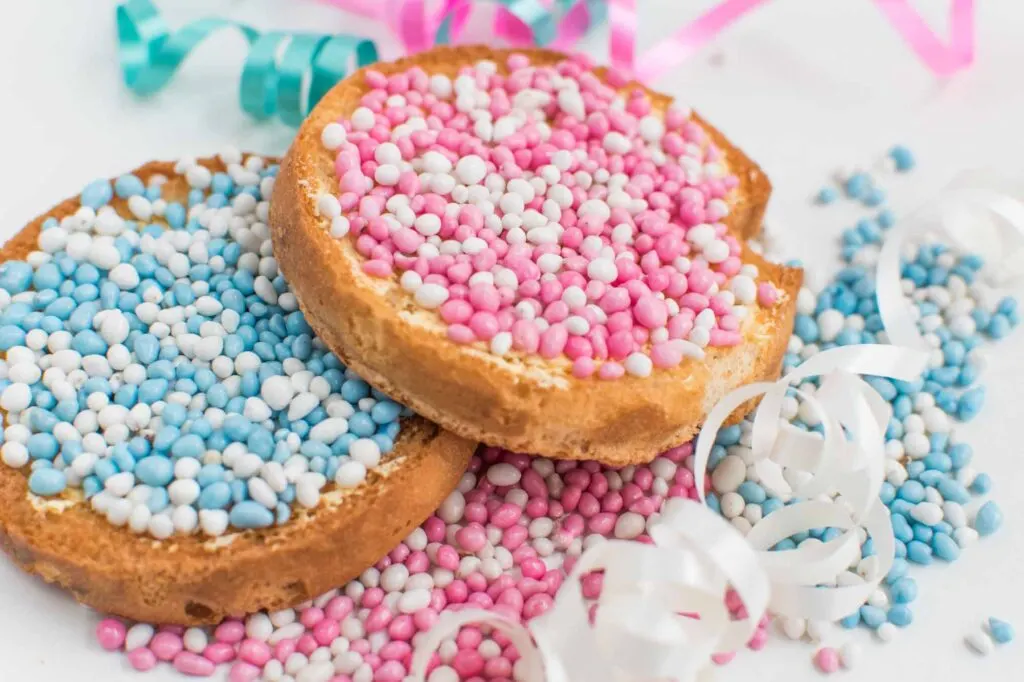
The name of this treat means ‘biscuit with little mice.’ Dutch parents usually give this treat when their babies are born.
It’s a round piece of toast with butter and aniseeds with a sugared and colored outer layer.
This layer can be colored either in blue or pink, which is determined by the baby’s gender.
30. Kruidnoten or Pepernoten

Children’s favorite treat (also true for some adults too), kruidnoot and pepernoot are Dutch cookies served during the holiday season, more precisely the Saint Nicholas holiday (Sinterklaas).
Kruidnoten is crispy spiced biscuits, slightly harder and darker than pepernoten. Its main ingredients are nearly the same as the speculaas cookies: white pepper, cardamom, cloves, cinnamon, ginger, and nutmeg.
On the other hand, pepernoten‘s main ingredients are aniseed, cinnamon, and cloves.
Traditional Dutch Food
The Netherlands is not only very charming and exciting, but it is also a country with many delicious bites for foodies like you and me.
We hope you can taste most of these traditional Dutch foods, if not all of them during your trip to the tulip’s country.
And when you do, please, come back here and let us know what you think about them, especially about drop! We would love to hear from you.
Did you like this post about traditional Dutch food? Then pin this post to your Pinterest board!
Our best travel tips & resources:
Here're our all-time favorite travel tips & resources so that you can save money and plan your travel logistics hassle-free! For more travel resources, check out our travel tips.- Saving money: Fly on offseason, winter (not Xmas or NYE), Tuesday, or Wednesday! According to experts, these are the cheapest days to fly.
- Travel insurance: Before you leave for your trip, make sure you have a valid travel insurance policy because accidents happen on the road. We have been paying for Safety Wing travel insurance for a little over a year now, and we happily recommend them to our family and friends.
- Accommodation: We usually stay in mid-range comfy hotels or private rooms in hostels. These are the sites we use to book accommodation: Booking.com for hotels (excellent flexible cancellation policy) and Hostelworld for hostels (low deposit and easy cancellation).
- Tours:We absolutely love booking guided tours with locals to get a history lesson while sight-seeing, especially food tours and walking tours! We book all of our tours using Viator and GetYourGuide.
- Transportation: We use Google Maps to figure out how to get around a place using public transport. When we book a rental car, we always use Discover Cars to find the best deal.

ellen blom
Thursday 10th of August 2023
I forgot to say -- Spek pannekoeken smaken beter met keukenstroop.
ellen blom
Thursday 10th of August 2023
From one Dutch person to another -- Eet Smakelijk!!!
Alex
Monday 22nd of May 2023
These foods look sooooooo god
Anneloes
Thursday 7th of July 2022
You have one double in here. Stamppot is a more general name for something mashed with potatoes, you describe specifically the one with kale. However, later you mention boerenkool, which is exactlly the same thing! Boerenkool is the dutch word for kale, but usually when we mean boerenkool-stamppot we leave out the 'stamppot' and just say boerenkool. The same goes for the other way around, when we only say stamppot, it is implied that we eat the default: made with kale/boerenkool.
Tjitjke
Tuesday 15th of February 2022
I have been trying for years to locate triple salted dropjes! Have to settle for double. Upside-I never have to share! No one else I know likes it.